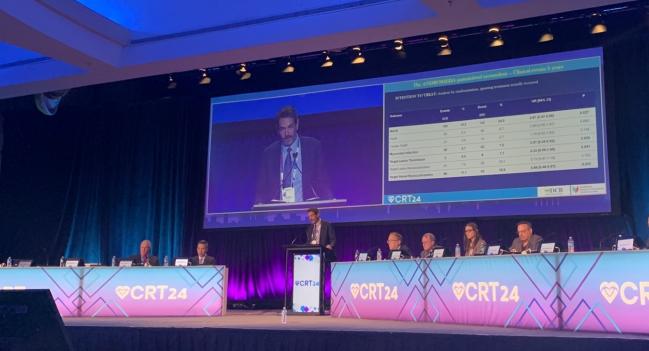Mixed Bag With DCBs for In-Stent Restenosis, Small Coronary Arteries
The emerging DCB era puts operator skills in the spotlight as key to interpreting outcomes data, says Mamas Mamas.

WASHINGTON, DC—Data on real-world use of drug-coated balloons (DCBs) compared with drug-eluting stents for in-stent restenosis (ISR) and de novo lesions in small coronary arteries shed light on their therapeutic similarities and differences, two presentations here at CRT 2024 show.
Presenting results from the SCAAR registry, David Erlinge, MD, PhD (Lund University, Sweden), noted that there are limited long-term data on DCB versus DES for in-stent restenosis, with no RCT having follow-up beyond 3 years. Additionally, many of the previous trials investigated either DES in-stent restenosis or BMS in-stent restenosis separately and have focused on specific types of DCBs, restricting the generalizability of these studies, all of which have been rather small.
The SCAAR data, from Sweden, show that TLR rates were lower with DCB at 1 year than with plain-old balloon angioplasty (POBA), which is in line with the AGENT IDE interim results that led to the recent approval in the United States of the Agent DCB (Boston Scientific), as was the rate of all-cause mortality. However, compared with DES, DCB was associated with higher rates of TLR and similar rates of all-cause mortality.
Compared with DES, DCBs were more often used in stable CAD and less often in type C lesions, while POBA was used more in STEMI patients (35% vs DES in 19% and DCB in 11%). This prompted Erlinge to say it’s “an interesting and important difference, which might have effect on mortality.”
Looking at ANDROMEDA, which was a patient-level analysis of four RCTs comparing DCB with DES in de novo lesions, the balloons were noninferior to the stents and were associated with fewer late adverse clinical events, said Bernardo Cortes, MD (Fondazione Ricerca e Innovazione Cardiovascolare, Milan, Italy), in his presentation.
We have more to learn than we know about DCBs right now. Gregg Stone
Moderator Gregg Stone, MD (Icahn School of Medicine at Mount Sinai, New York, NY), noted that emerging data have ushered in a new era, particularly in the United States, for DCBs.
“We have more to learn than we know about DCBs right now. We need to understand for ISR their long-term outcomes,” he said. “We need to understand more about their outcomes in respect to drug-eluting stents. We see enticing data that there may be some superiority compared to DES in small-vessel de novo disease, but we don't have any big, randomized trials about that, certainly not in the US, and that would be off-label use.”
Additionally, Stone said the costs of DCBs compared with alternatives will be part of these conversations moving forward.
SCAAR Analysis
The SCAAR data presented by Erlinge are based on 9,304 in-stent restenosis lesions from 7,987 patients (mean age 69 years; 22% women) treated between 2013 and 2020. Of these, 2,865 lesions were treated with DCBs, 5,426 with DES, and 1,013 with POBA. Use of IVUS or OCT was low at rates of 13% for DCBs, 14% for DES, and 22% for POBA.
At 5 years, the TLR rate was highest for POBA at 18.5%, followed by DCBs at 18% and DES at 12.7%. In terms of other endpoints, all-cause and CV mortality were highest with POBA, with similar rates between DCB and DES patients, while rates of MI and need for any PCI were lowest in DES patients. Adjusted Cox regression analysis confirmed the higher TLR rate with DCBs compared with DES (HR 1.24; 95% CI 1.08-1.42).
In subgroup analyses, TLR was less common in patients over age 80 treated with a DCB versus DES (P for interaction = 0.001).
Perhaps the time of using POBA in these patients is well and truly over. Mamas A. Mamas
Mamas A. Mamas, BMBCh, DPhil (Keele University, Stoke-on-Trent, England), who commented on the SCAAR results for TCTMD, suspected that the age-related finding was likely due to competing risks of mortality, but he added that since the study doesn’t separate outcomes by generation of DES, it is difficult to draw firm conclusions.
“The other thing that is really interesting is when you look at the absolute numbers, very few patients were being treated with POBA,” he noted. “I think that's a really powerful message that perhaps the time of using POBA in these patients is well and truly over.”
Mamas agreed with Erlinge that the high use of POBA in the cohort’s STEMI patients is a noteworthy finding difficult to justify in the contemporary era.
ANDROMEDA Results
In his presentation, Cortese said small-vessel disease is an area where growing the DCB literature is of particular interest. The largest study looking at DCB in small-vessel CAD is BASKET-SMALL 2, which showed noninferiority of a paclitaxel DCB compared with DES at 3 years for the primary endpoint of MACE. Another study, PICCOLETO II showed a reduction in MACE with a paclitaxel DCB compared with a DES at 3 years, but the trial was small and not powered for hard clinical endpoints.
For ANDROMEDA, Cortese and colleagues conducted an investigator-initiated patient-level meta-analysis of 1,145 patients (mean age 67 years; 24% women) enrolled in BASKET-SMALL 2, PICCOLETO II, BELLO, and RESTORE SVD China.
At a mean follow-up of 3 years, the MACE rate was 24.5% in the DES group versus 18.5% in the DCB group (P = 0.027). Rates of MI, target-lesion thrombosis, and TVR also were lower with the DCB. On Kaplan-Meier analysis, there were no differences in TLF between the two groups.
“Ongoing trials like TRANSFORM II and SELUTION will shed light on this therapeutic opportunity by means of direct randomization and larger populations,” Cortese concluded.
Mamas agreed, noting that the emerging use of DCBs highlights the importance of operator skill sets. These are and will continue to be, he said, a key component when interpreting and relying on outcomes analyses like those from SCAAR and ANDROMEDA.
“I think people are realizing that with DCBs, in many ways, it’s more challenging that using a stent. With a stent you get consistent results. They are in many ways more forgiving.” he said. “With DCB, many of your longer-term outcomes are dependent on how you prepare your lesions. If you just put in a balloon and hope for the best, the likelihood is you’re not going to get great results. So, it’s always a challenge in analyses to interpret outcomes on the background of not knowing how well people are using the tools they have available to them.”
Note: Mamas serves as Senior Clinical Editor for TCTMD.
L.A. McKeown is a Senior Medical Journalist for TCTMD, the Section Editor of CV Team Forum, and Senior Medical…
Read Full BioSources
Erlinge D. Drug-coated balloons vs drug-eluting stents or plain old balloon angioplasty for in-stent restenosis: a nationwide segment-level analysis from SCAAR of 7,987 patients. Presented at: CRT 2024. March 9, 2024. Washington, DC.
Cortese B. Assessment of long-term clinical outcomes of de novo DCB performance: a comprehensive, individual patient data meta-analysis of randomized clinical trials: the Andromeda study. Presented at: CRT 2024. March 9, 2024. Washington, DC.
Disclosures
- Erlinge reports no relevant conflicts of interest.
- Cortese reports consultant/honoraria/speaker's bureau fees from Concept Medical, B. Braun, Abbott, Amgen, Cordis, and Microport.





Comments